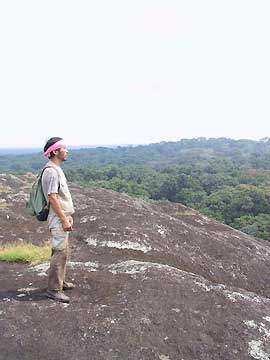
This is an account of a journey in Cameroon in 2001.
On the way back from the field with the graduate students Shiho Hattori and Hirokazu Yasuoka, I visited a place called "Ekok Edanbawa" in the tropical rain forest in the south east of the country.
It was a place that I had noticed before, while looking at the map. It was well to the south of the area that I could reach by walking, and was located in the middle of the forest, inaccessible by road. On the map, there was a mysterious symbol looking like a beacon. The symbol was not included in the legend, and was not repeated anywhere else on the map.
When we listened to what the pygmies and farmers had to say, some claimed that the symbol signified a huge rock, so big that "when you climb it, you can see aircraft flying below you." Hattori said "let's try going there," Yasuoka agreed. (Kagari Shikata, who was also there, couldn't accompany us because she was tired out from work and was feeling feverish.)
The nearest village to the place we wanted to visit was 20 km distant, so we equipped ourselves with tents and some food and got four farmers and pygmies to act as our guides. At the end of the first day, we stayed at an abandoned campsite that we came across on the way. On the second day, after fording many rivers that were like muddy paddy fields, just before noon we finally struggled through to Ekok.
There really was a giant rock. It towered above the forest canopy and was perhaps 80 meters high. It had a domed surface devoid of grass or trees, and reared up abruptly out of the forest. The way back was hard, but as I walked along I was buoyed up with pleasure at the thought that I was probably the first Japanese ever to have seen this wonderful spectacle. We stayed once more at the place where we had camped the previous day, and on the third day we returned to the village. Hattori was footsore and in the end had to go around in sandals.
Good bye! |
 Postcards from the Field
Postcards from the Field